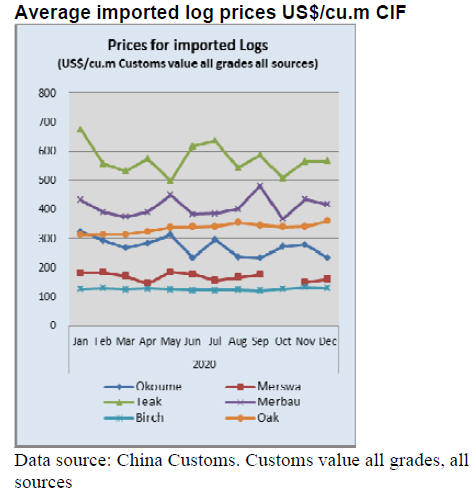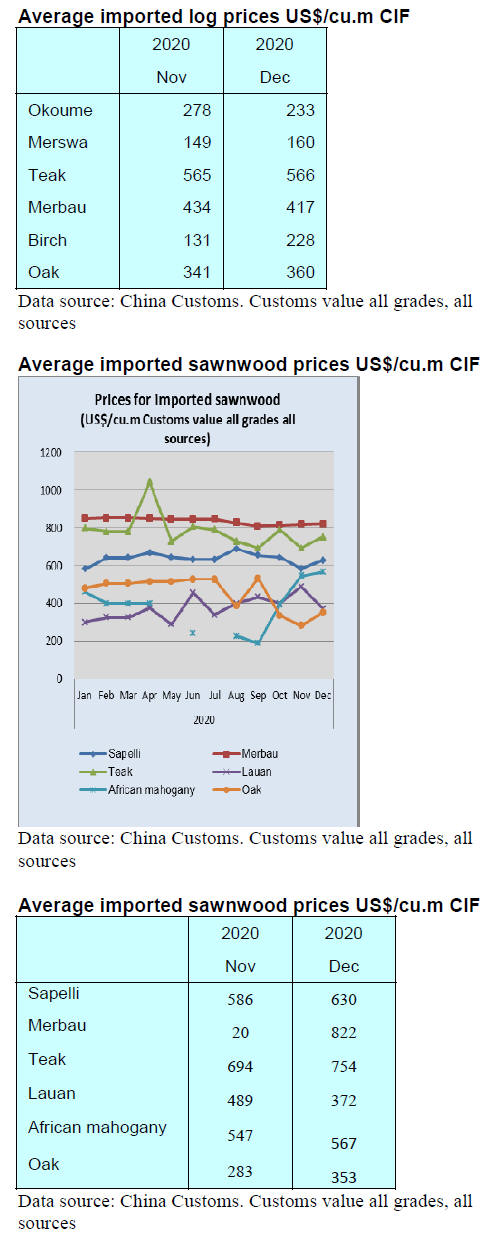US Dollar Exchange Rates of
10th March
2021
China Yuan 6.5066
Report from China
Particleboard and fibreboard production capacity
trends
The National Planning and Design Academy for the Forest
Products Industry under the State Administration of
Forestry and Grassland and the China National Forest
Products Industry Association has released an analysis of
China¡¯s particleboard and fibreboard industry.
Particleboard
The report says an additional 16 particleboard production
lines with a production capacity of 3.09 million cubic
metres per year were in operation nationwide in 2020.
There were 329 particleboard production enterprises and
348 particleboard production lines distributed in 24
provinces, municipalities and autonomous regions in
China by the end of 2020 with a total production capacity
of 36.91 million cubic metres per year, down 3.5% from
the end of 2019. The average single-line production
capacity further increased to 106,000 cubic metres per
year.
The top 10 provinces in terms of particleboard production
capacity are Shandong (7.41 million cu.m per year),
Guangdong, Hebei, Guangxi (3.25 million cu.m per year)
and Jiangsu, Anhui, Henan, Hubei, Sichuan and Fujian
provinces.
The total production capacity of particleboard in China
experienced rapid growth for four years in a row and then
decreased slightly as the number of enterprises fell.
About 92 particleboard production lines nationwide were
closed or suspended production in 2020 eliminating some
5.8 million cubic metres of production capacity.
By the end of 2020, a total of 1,123 particleboard
production lines had been shut down, dismantled or
stopped production and some 27.72 million cubic metres
of production capacity had been eliminated.
China had in production 3 new production lines for
oriented particleboard in 2020 with an additional
production capacity of 850,000 cubic metres per year. By
the end of 2020, China had 26 oriented particleboard
production lines with a total production capacity of 4.16
million cubic metres per year, an increase of 18% from the
end of 2019. These mills are distributed in seven provinces
and regions, including Shandong, Hubei, Guangxi, Anhui,
Jiangsu, Guizhou and Yunnan provinces.
25 particleboard production lines were being built in early
2021with total production capacity of 6.75 million cubic
metres per year. There are particleboard production lines
under construction in the 7 main regions (east China, south
China, central region, southwest, north China, northeast
and northwest regions), including 18 continuous flatpressed
production lines with the total production capacity
of 5.72 million cubic metres per year, accounting for 84%
of the particle board production capacity under
construction.
The particleboard production lines under construction will
be put into operation from 2021 to 2022 and it is estimated
the national particleboard production capacity could
exceed 40 million cubic metres per year by the end of
2021.
See:
http://www.cnfpia.org/sf_6EB6F5386E324C31B3D1A22300903ECC_297_9E5BA0FB363.html
Fibreboard
China¡¯s fibreboard sector is characterized as follows:
15 fibreboard production lines were built in 2020 adding
2.76 million cubic metres per year of capacity.
There were 392 fibreboard manufacture enterprises, 454
production lines in China distributed across 25 provinces,
cities and regions by the end of 2020. Total production
capacity was 51.76 million cubic metres, down 1.3% from
the end of 2019. The capacity per production line rose to
114,000 cubic metres per year.
The top 10 provinces in terms of fibreboard production
capacity are Shandong (7.98 million cubic metres per
year), Hebei (5.66 million cubic metres per year), Guangxi
(5.35 million cubic metres per year), Jiangsu, Guangdong,
Anhui, Henan, Hubei, Sichuan and Yunnan provinces.
The total production capacity of fibreboard in China
declined slightly after two consecutive years of growth
showing a general trend of the number of enterprises, the
number of production lines.
China shut down, dismantle or stopped production in
about 118 fibreboard production lines in 2020 eliminating
about 7.88 million cubic metres of production capacity
per year.
A total of 781 fibreboard production lines had been shut
down, dismantled or stopped production by the end of
2020 eliminating 33.16 million cubic metres of production
capacity per year.
There were 136 continuous flat-pressed fibreboard
production lines in China by the end of 2020 with a total
production capacity of 26.92 million cubic metres per
year, accounting for 52% of the national total fibreboard
production capacity. Mills are distributed in 19 provinces
(regions). The top seven are Shandong, Guangxi, Hebei,
Hubei, Anhui, Guangdong and Henan.
22 national fibreboard production lines were being built in
early 2021 with the total production capacity of 4.86
million cubic metres per year, fibreboard production lines
are under construction in the East China, south China,
central China, northwest, north China and Northeast
regions except southwest region. The fibreboard
production lines under construction will be put into
operation from 2021 to 2022 and it is expected that the
national total fibreboard production capacity will reach 55
million cubic metres per year by the end of 2021.
See:
http://www.cnfpia.org/sf_233C8F4BD30B4BB285003D512B8D711E_297_9E5BA0FB363.html
Changsha City - the main border crossing for Russian
timber
Construction of the Container Center at the Central and
Southern Land Port to serve the China-Europe Railway
Express (Changsha) is being accelerated in Changsha City
of Hunan province.
The construction will provide the foundation for expansion
of the China-Europe Railway Express (Changsha) to meet
the international logistics needs of the large number of
small and medium-sized enterprises in the region.
Statistics show that the China-Europe Railway Express
(Changsha) saw an explosive growth in 2020with a total of
530 trains shipped exceeding the total number during a
four year period from 2014. The value of cargo
transported was US$2.06 billion, a year-on-year growth of
99%.
At present, Trains from Changsha City have gone to
Russia, Minsk, Malaszewicze, Budapest, and Central Asia
and returned from Hamburg, Budapest, Central Asia and
Russia. 9 to 12 trains operate weekly in Changsha City
serving 27 cities in 12 countries.
A large volume of Russian timber has been shipped to
Changsha City via the China-Europe Railway Express
(Changsha) and distributed across the country. Changsha
City is the main entry point for Russian timber at present.
Analysis of current timber market prices fluctuations
Many members of China¡¯s timber associations have
reported increases in timber prices are of concern as they
impact production costs. The most serious price
fluctuations have been for softwood logs, At present prices
for hardwood logs are relatively stable.
The secretariat of the China Wood Protection Industry
Association (CWPIA) undertook an analysis and this is
summarised below.
The first cause of price increases is the pandemic. Demand
for wood products in the United States, Canada and parts
of Europe has increased. Raw material suppliers to China
see an opportunity to raise prices on the back of growing
demand.
Second is the impact of land and sea freight. The
pandemic has had a significant impact on international
trade. Port inspections and quarantine have become stricter
and the flow of containers has been disrupted and shipping
companies have raised container shipping costs.
The third is the impact of supply and demand. In 2020,
China's timber imports totaled 108.02 million cubic
metres, down about 5% year on year. The main suppliers
of timber such as Russia, New Zealand and Canada saw
demand fall. Stocks in supply countries and in China have
fallen leading to a temporary imbalance between the
supply and demand of timber which has pushed up prices.
The Association suggests that eventually the pandemic
will gradually be controlled and production and exports
will gradually recover in the main timber production
countries.
See:
http://www.cwp.org.cn/vip_doc/19836251.html


|